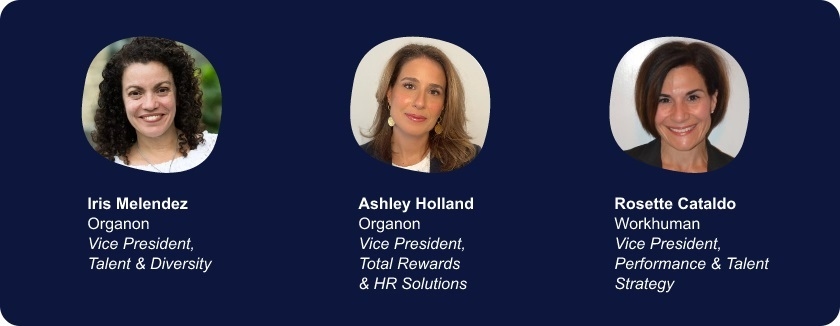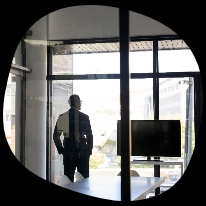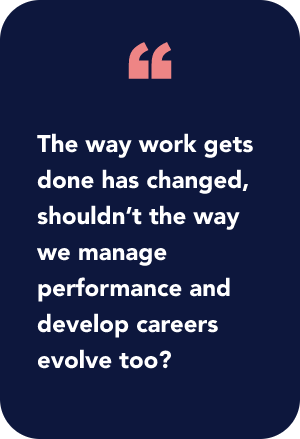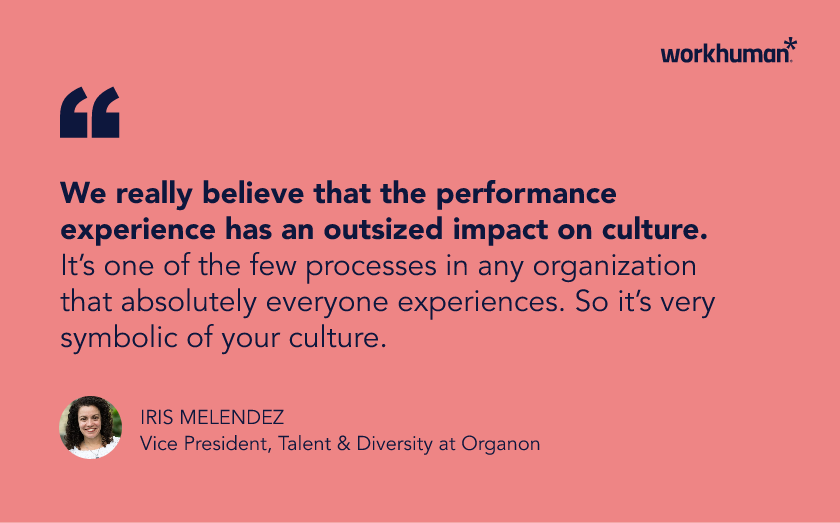A Modern Performance Management Model: How Organon Reimagined Their Framework For Success

Why did Organon, a dynamic new healthcare organization for women, embrace a progressive, innovative performance management model?
“If you really believe that performance management has an outsized impact on your culture, then it means all of us need to experience something that’s different and new,” observed Iris MelendezOpens in a new tab, Organon’s vice president of talent and diversity in a recent Workhuman® webinar. She was joined by Organon’s Ashley HollandOpens in a new tab, vice president, rewards and HR solutions, and Rosette CataldoOpens in a new tab, vice president of performance and talent strategy at Workhuman.

Together, they explored how the traditional performance evaluation model – “a heavy process based on timelines, ratings, and labels” that culminates in the dreaded annual review – just wasn’t going to cut it for Organon.
As Ashley noted: “For a process that important, that foundational, that touches every ‘founder,’ you have to make a change.” (As a recent Merck spin-off, Organon calls employees ‘founders.’)
That change, as we will discover, involved a complete rethinking of what employee performance means and how it is shaped at Organon.

Traditional performance management models
Let’s face it … no one is happy with the annual performance review. Not the employee. Not the manager. Not even human resources.
That’s because the traditional performance appraisal is based on an antiquated notion that a manager – someone who may not be fully aware of what the employee even does on a day-to-day basis – can inspire and coach a worker to new heights of engagement and productivity by meeting once or twice a year.

“In most organizations, you have a very strict timeline,” observed Iris as she discussed the traditional performance management cycle. “There are deadlines that managers must follow. HR is often the enforcer of those timelines. It’s an all-consuming process that takes a couple of months out of every year. And it’s heavy.”
Yet for decades the performance management cycle has been the same. Each year, the manager sits down with the employee and explains what the worker was doing right or wrong.
If the employee was lucky, she’d get a pay increase.
And if she was called into the boss’s office at any other time of year, it was usually because something was wrong – not a great formula for fostering employee motivation.
That’s why Organon wanted to break the mold on performance reviews. “We didn’t want a very heavy process that was about timelines, ratings, and labels,” noted Iris. “We wanted a process that was about people; that was about enabling our values and our culture.”
Stages of the traditional management cycle
Most “traditional” approaches to performance management include prescribed, formulaic stages or steps that define the cycle. Some examples of performance management models include:
PCER (Plan, Coach, Evaluate, and Reward) – In this approach, the manager – ideally in concert with the employee – develops a performance plan to set employee goals, offers coaching to help the employee complete the plan, and carries out an annual performance evaluation that determines the reward (compensation) the employee is to receive.
5 Stage Model (planning, monitoring, developing, rating, rewarding) – This model outlines the five steps in the performance management process:
Step 1: Create a Performance Management Plan.
Step 2: Set Goals for Performance Management.
Step 3: Build a Performance Review System.
Step 4: Develop Strong Feedback-Giving Skills.
Step 5: Ongoing Employee Performance Management.
Enter continuous performance management
But as Organon demonstrated, there’s a more modern, progressive and smart method to engage, motivate, and inspire employees — while meeting organizational objectives. The continuous performance management cycle model.

They recognized that the way work gets done has changed – even more so in the new hybrid and remote work dynamic generated by the pandemic. Now the emphasis has shifted toward networks of fast-moving, highly collaborative teams.
Given this dynamic, they asked the question: Shouldn’t the way we manage performance and develop careers evolve too? After all, even the most traditional industries are moving away from the annual review to a continuous performance management process that unfolds in the flow of work.
In fact, today the debate isn’t about whether the traditional, isolated annual performance evaluation is effective – it isn’t. It’s about how to replace or supplement it, and with what.
That’s where a continuous performance management system comes in.
As Ashley noted, for employees who have been part of traditional performance management systems, “there was a very common, universal feeling of dislike. I don’t think people really felt satisfied by the process. As so, as we were establishing a process at Organon … I think everybody felt there had to be a better way.”
Organon recognized that continuous performance management is a modern, human-centered approach to promote, evaluate, and improve employee performance. It enables an organization to create a trusted environment in which employees feel empowered to take control of their own development.
In a culture of true continuous performance management, employees support each other with a wide range of real-time performance feedback – celebratory, instructive, and constructive.
Work cultures that embrace continuous performance feedback:Foster a forward-looking growth mindset by emphasizing feedback that is in-the-moment, informal, and frequent.Strengthen relationships by improving communication and coaching between employees, managers, team leaders, and mentors.
As Organon sees it, continuous performance management is about growth and development. It’s about creating a culture where people are comfortable giving feedback up, down, and across an organization. And it’s about helping employees – and the organizations they work for – realize their full promise and potential.
Employee development based on recognition
As Organon demonstrated, an effective performance management strategy begins with a foundation of trust and gratitude, generated through a strategic, comprehensive employee recognition program.
Positivity is the baseline on which growth happens. It becomes the protective foundation in which constructive feedback becomes a welcomed learning opportunity.
At Organon, they drew upon Merck’s highly successful recognition program, based on the Workhuman platform. “We really wanted to leverage the strong culture of recognition we had at Merck,” noted Ashley. “But also build upon it and make it our own. And we did that by linking to our values.”
Celebrating employees — both at and outside of work
The company also saw an opportunity to expand the program beyond workplace recognition to include those special moments individual employees celebrate outside of the workplace. “Our founders have lives that go beyond the workplace,” said Ashley.

“And so ‘celebrate’ is a way for us to acknowledge all the important moments that they have going on in their lives – publicly or privately – based on their preference. It’s important to recognize who we are at work, and our accomplishments at work, but it’s also important to recognize and celebrate who we are outside of work.”
“Part of the Workhuman® Platform is having these moments of connection where – whether the celebration is because I just bought a new home, or I had a birthday, or I got promoted – it’s surfacing these moments that make it possible for me and my colleagues to get a greater connection,” added Rosette.
Check-ins — creating a safe space for feedback
In Organon’s culture of continuous feedback, trust increases, and employees feel safe giving and receiving feedback from their colleagues or manager. In such a culture, they even seek it out. Check-ins with managers become positive experiences rather than events that engender anxiety and stress.
What an effective performance management model looks like
At Organon, performance management isn’t something that managers “do.” “It’s the founders [employees] who decide when it is time to have a check-in,” explained Iris, rather than following the timeline of human resources.
“When do I feel like I need that feedback? How often? The founder is empowered to make those decisions to seek feedback from the people they interact with at work. They decide when it is time to sit down with the manager for a check-in to discuss the feedback they’ve collected.”
The beauty of such a performance management model is that it creates a culture of psychological safety, one in which feedback is welcomed and celebrated. That’s important because – as we all know – feedback has an image problem.

As Dr. David Rock explained at Workhuman® LiveOpens in a new tab, just hearing the word “feedback” gets defenses up and sends shivers down the spine. It immediately triggers an emotional defense mechanism and tends to make people shut down.
But a modern performance management model creates a culture of trust in which employees support each other with a wide range of two-way feedback that’s celebratory, instructive, and constructive. It creates a culture where people are comfortable giving feedback up, down, and across an organization – and enables all employees realize their full potential.
“When you put the founder at the center, it creates more psychological safety, in which I’m more receptive to feedback because I have requested it,” adds Iris. “That’s the biggest difference for us – the founders own it. It’s not this big process that everyone is doing at the same time on some artificial company deadline. It’s the founder who’s building feedback into the everyday flow of their work – whenever they think it makes sense for them.”
On the employee experience
Because Organon has implemented the entire Workhuman Platform – recognition, performance management, and life events and community celebrations – they are able to deliver a more unified and positive employee experience.
“Your employees don’t care about how you’re structured,” explained Iris. “They don’t care about how the HR team is set up, and who’s responsible for what. It’s one experience for them at the end of the day … If I was trying to promote a continuous cycle of feedback and check-ins — but we had an annual compensation process — that would be a real disconnect. That would be like driving with one foot on the gas, and one foot on the brake.”
On culture
On the subject of culture, Organon’s CEO and executive team “wanted to be very intentional about the type of culture we were building for Organon,” recalled Iris.
“They were working on it for years, defining the values and culture of the company … We really were able to act as change agents to create the type of culture that the business leaders wanted for Organon. And that’s why we were designing the way we are – because we know that culture is really shaped greatly by the performance management process.”
“We really believe that the performance experience has an outsized impact on culture,” she added. “It’s one of the few processes in any organization that absolutely everyone experiences. So it’s very symbolic of your culture.”

On compensation
“I think pay practices should be cultural enablers,” observed Ashley. “I really think you need to lead with performance. I think too many companies have been bound by financial constraints.”
While recognizing that a company has to have budgets for their rewards programs, she believes they shouldn’t dictate or govern the employee’s performance experience.
To do otherwise is to lose the credibility of the process, and “lose the hearts and minds of employees.”
In short, companies have to “lead with performance,” noted Ashley. “I think you build a set of practices that help and support your performance experience. And you do all that with your culture and your values in mind.”

Creating a performance management framework
According to Iris, the first step in creating a performance management framework at Organon was to ask the tough questions.
“Why do we even do performance management in the first place? What is the purpose of that process? And what’s the philosophy behind it?” As Iris noted, their performance management framework is grounded in the organization’s values and company culture.
For Organon, the framework begins with a purpose, which formulates a philosophy, and culminates in principles.
Choose people over process.
Bring modern performance management to your organization
Learn how you can fuel a continuous performance management culture in your organization. Give employees a single, ongoing resource for development that reflects how successful work gets done. It’s all possible with Conversations®, part of the Workhuman Platform!